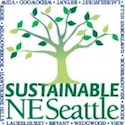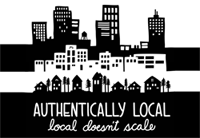This is part of the essay “Ravenna Park (Seattle)“, appearing here thanks to HistoryLink.org and author Peter Blecha, under a Creative Commons license.
[If you’re new to the series, you can start with Part 1 here.]
Visiting the A-Y-P Exposition and Ravenna Park
Meanwhile, the city’s business and political leaders were involved in planning for 1909’s Alaska-Yukon-Pacific Exposition — a world’s fair that would bring countless tourists to the area. With the A-Y-P Exposition being mounted on the University of Washington campus just a dozen blocks south of his park, Beck — believing that throngs of expected fairgoers might easily be tantalized into making a side-trip to relax in the shady ravine — again offered to sell his park to the City in 1908. The City declined. Beck snapped, Fine. “I have in Ravenna Park things that will entertain Seattle’s visitors more than all the things the fair management can possibly assemble in hot, crowded buildings” (Bush).
In preparation for the expo, the Becks recruited the prominent University of Washington historian Edmond S. Meany (1862-1935) to help create an inventory of the park’s flora and also stoked community enthusiasm in 1908 by inviting various social clubs to suggest names for various big trees. Louise dedicated the one named for her musical friend, the “Paderewski Tree.” Fritz Kreisler was honored with the naming of the park’s Kreisler Falls. The United Daughters of the Confederacy named the tallest tree (400 feet) the “Robert E. Lee Tree.” Other trees were dubbed Adam, McDowell, Pan, and the Siamese Twins. The Becks also had a bit of fun by naming a pair of trees that crowded one another after Seattle’s feuding mayor and fire-and-brimstone preacher, Hiram C. Gil (1866-1919) and Rev. Mark Matthews (1867-1940).
Other new features added to the park were exotica curiosities — including an Indian “war canoe,” a teepee, a wickiup (mat lodge), and five totem poles — to increase tourist interest. The Cowen Park Bridge also proved to be an attraction. One visitor to Seattle at about that time was an excited Texas girl named Mary R. Watson whose handwritten diary contains the following passage:
“August 4th — took the University car for Ravenna National Park [sic] where we passed the Cowen Park. Revenna [sic] contains 50 acres of woodland which man has never touched. The most beautiful footpath I have ever walked upon. Drank at the sulfur and iron Springs, walked 1 1/2 miles and then ascended to a high and long bridge, which crossed over the Ravine [sic] Park …” (Mary R. Watson).
The Becks experienced plenty of changes over the years including the fact that they bore two sons — Dillard R. Beck (1912-1989) and Broussais C. Beck (1914-2008) who eventually gave them five grandchildren. And too, it was in 1910 that the couple embarked on a trip to Europe — including a stop in Ravenna, Italy, where they visited the tomb of Italian poet Dante Alighieri and signed the visitors’ guest book kept there.
Next week: Seattle’s Heavy Hand
______________________
Sources:
W. W. Beck, Ravenna Park – ‘Im Walde,’ (1903), Peter Blecha collection, Seattle; W. W. Beck, Ravenna Park – ‘Im Walde,’ 16-page postcard booklet, undated, in Peter Blecha collection; W. W. Beck, Ravenna Park (ca. 1909), Peter Blecha collection; “Ravenna Park Guide,†brochure, 1909, Peter Blecha collection; “Ravenna Or Big Tree Park: It is Famous = “Nature’s Exposition,†postcard, 1909, Peter Blecha collection; Harvey Manning, Winter Walks and Hikes (Seattle: Mountaineers Books, 2002), 42; Betty McDonald, Anybody Can Do Anything (Philadelphia / New York: J. B. Lippincott Co, 1950), 129-130; Paula Becker, “Time Traveling The Roosevelt District With Betty Macdonald,†Seattlepress.com website accessed July 13, 2010 (http://seattlepress.com/article-9455.html); “One of Ravenna’s Giant Trees Christened ‘Paderewski,’†Interlaken, February 8, 1908, p. 1; Sophie Frye Bass, When Seattle Was A Village (Seattle: Lowman & Hanford Co., 1947), 106-108: David Buerge, “Indian Lake Washington,†Seattle Weekly, August 1-7, 1984; Seattle Polk City Directory (1901-1934); Directory of the National Society of the Daughters of the American Revolution (Washington D.C.: Memorial Continental Hall, 1911), 1340; “Mrs. L. C. Beck Funeral To Be Held Today: Woman Widely Known In Musical and Club Circles Is Mourned By Seattle Friends,†Seattle Post-Intelligencer, July 9, 1928, p. 13; Kate C. Duncan 1001 Curious Things: Tales from Ye Olde Curiosity Shop (Seattle: University of Washington Press, 2000), 73-78; Andrea Casadio, email to Peter Blecha, January 30, 2008; “No Finer Site: The University of Washington’s Early Years On Union Bay,â€Â Web exhibition, University of Washington Libraries website accessed August 19, 2010 (http://lib.washington.edu/exhibits/site/); HistoryLink.org Online Encyclopedia of Washington State History, “Seattle’s Ravenna Park Bridge is constructed in 1913″ (by Priscilla Long), and “WPA builds Cowen Park Bridge in Seattle’s Ravenna neighborhood in 1936″ (by Priscilla Long), and “John Olmsted arrives in Seattle to design city parks on April 30, 1903″ (by David Williams and Walt Crowley), and “David Thomas Denny (1832-1903)†(by David Wilma), http://www.historylink.org/ (accessed August 1, 2010); Esther Campbell, Bagpipes in the Woodwind Section (Seattle: Seattle Symphony Women’s Association, 1978), 9; William Arnold, “The Great Mystery of Ravenna Park,†Seattle Post-Intelligencer, Northwest Today section, December 17, 1972, pp. 8-9; Steve Cronin, “Ravenna Park’s Famous Trees Vanished Furtively,†UW Daily, May 25, 1977, p. 3; James Bush, “Remembering William W. Beck: The Father of Ravenna Park,†The Seattle Sun, August 2003, The Seattle Sun website accessed August 25, 2010 (http://parkprojects.com/2003news/0308aug/hisbeck.html); Mary R. Watson, travel diary (handwritten), 1910, portion accessed on eBay, December 2006, copy in possession of Peter Blecha; Russ Hanbey, “1916 Seattle was a Hotbed of Sin When 2 Officers Were Killed,†The Seattle Times, February 6, 2010 (http://seattletimes.nwsource.com); and Peter Blecha archives.








Stay Connected